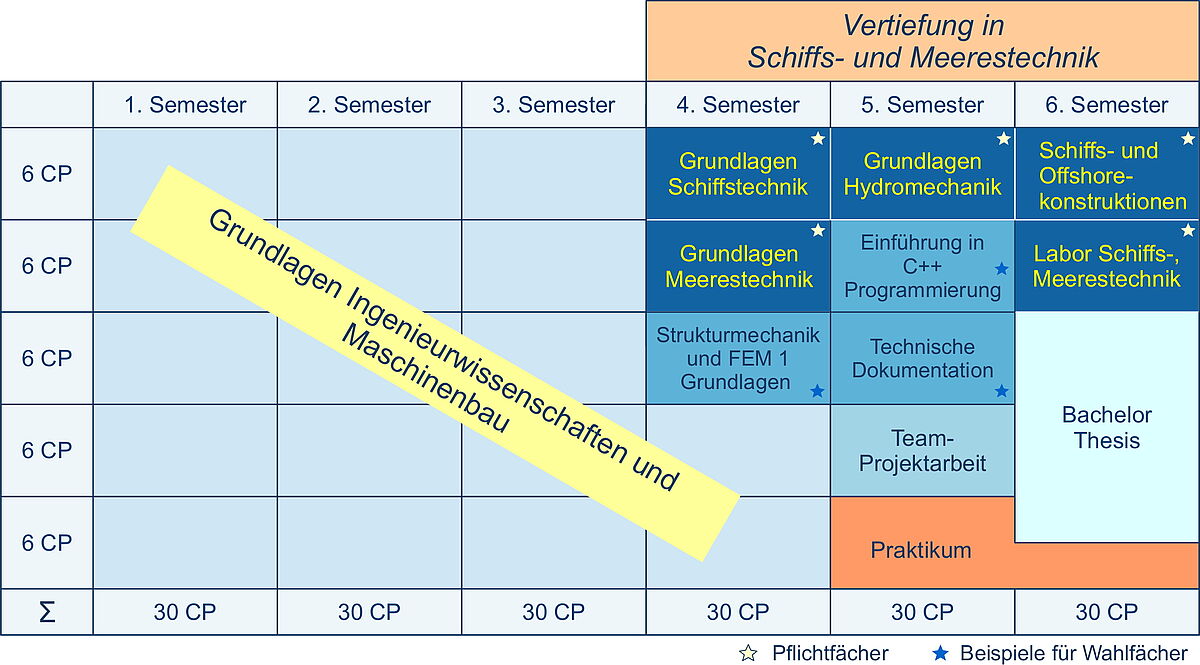General Information
Modules
Winter Semester
- Ship Design (M.Sc.)
- Damage Stability of Ships (M.Sc.)
- Computer-aided Design and IT in Ship Design ,Production and Operation (M.Sc.)
- Team Project EMship (M.Sc.)
Summer Semester
- Basic of Ship Technology (B.Sc.)
- Resistance and Propulsion (M.Sc.)
- Lab in Naval Architecture and Ocean Engineering (B.Sc.)
Offers to students
Downloads
Course: Basics in Ship Technology
Bachelor mechanical engineering
Providing basic knowledge of the ship's transport system and the methods for design based on a transport task or specification. Specification of important subsystems of a ship in relation to their basic parameters. These include the main dimensions with the shape of the ship and its significant influence on stability, space and resistance, the supporting structure, the propulsion system by interaction of ship, propeller and machinery, the equipment and equipment as well as e.g. cargo facilities. Acquisition of basic knowledge about the buoyancy and stability of floating structures, the calculation of ship shape parameters and the evaluation of loading conditions with regard to the floating position and stability. Application of the relevant, internationally valid IMO stability and freeboard regulations.
- Terminology definition, tasks of ships, transport tasks, worldwide cargo flows, types of ships, types of cargoes
- Ship types, distinguishing features from other transport carriers, system classification: shape, superstructure, space division, structure, machinery
- Transport task -> design process: determination of main dimensions
- Space, mass balance
- Ship hull form development
- Resistance estimation for performance prediction
- Propeller + machinery concepts
- Introduction to hydrostatics, Archimedes
- Changes in floating position: hydrostatic matrix
- Initial stability GM
- Heeling test
- Lever arm curve
- Ship safety: IMO IS-Code
- Development process, Maritime industry; Actors involved, tasks,
Organizations: Classification societies, testing laboratories, International Maritime Organization (IMO)
Edward V. Lewis, Editor
Principles of Naval Architecture, Volume I, II und III
The Society of Naval Architects and Marine Engineers, New Jersey, 1988
Signatur URO-BIB: ZO 6200 L673-1, -2, -3
H. Schneekluth
Entwerfen von Schiffen
Koehler Verlag, Herford, 1985
Signatur URO-BIB: ZO 6200 S358 E6(3)
David G. M. Watson
Practical ship design, 1. ed.
Elsevier, 1998,
Signatur URO-BIB: ZO 6200 W338
Schneekluth, Herbert, Bertram, Volker
Ship design for efficiency and economy, 2. ed.
Butterworth-Heinemann, 1998
Signatur URO-BIB: ZO 6200 S358 S5(2)
Bronsart, Robert
Glossar Schiffstechnik
Signature URO-BIB ZO 6200 B869
This course teaches the fundamentals of marine engineering. It is thus to be regarded as an introductory mandatory course for those students who wish to specialize in the field of marine and ocean engineering. The contents of the first three semester's courses are assumed as prior knowledge.
The contents and knowledge imparted in this course serve as a basis for the further courses of the specialization in naval architecture and ocean engineering as well as for the following master's degree. It is recommended to take the parallel course "Ship and Offshore Structures", which focuses on the structure of maritime systems and complements the contents of this lecture.
Course number: 21045
Courses: Basics of Ship Technology
Univ. Prof. Dr.-Ing. Florian Sprenger
M.Sc. Iven Sponholz
M.Sc. Junheng Zhang
Credit points: 6
Attendance: 2 SWS lectures, 2 SWS exercises/practicals
Scope of work:
- Classes: 2 SWS lecture, 2 SWS exercise/seminar
- Preparation, follow-up, self-study, homework: ~ 124 h
- Total workload: ~ 180 h

